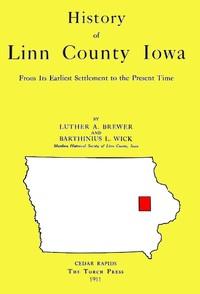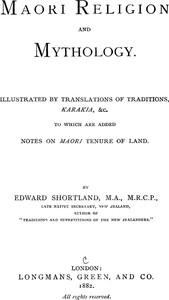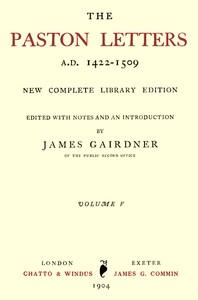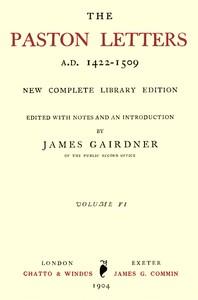|
|
Read this ebook for free! No credit card needed, absolutely nothing to pay.Words: 287506 in 76 pages
This is an ebook sharing website. You can read the uploaded ebooks for free here. No credit cards needed, nothing to pay. If you want to own a digital copy of the ebook, or want to read offline with your favorite ebook-reader, then you can choose to buy and download the ebook.

: History of Linn County Iowa From Its Earliest Settlement to the Present Time [1911] by Brewer Luther Albertus Wick Barthinius L Barthinius Larson - Registers of births etc. Iowa Linn County; Linn County (Iowa) History; Linn County (Iowa) Biography@FreeBooksWed 07 Jun, 2023 se have been mentioned and then only incidentally. The scope of this sketch does not allow adequate individual reference to the remainder. Nor is this the place to record contemporary progress. The lives of all the present members of the profession belong not to the past but to the future history of medicine in Linn county. The attached list gives the names of the practicing physicians in Linn county in 1910: In scarcely any locality has the material growth been so fast and substantial during the past seventy years as in Linn county. Old residents who have returned after a period of twenty-five to thirty years mention this fact, and what is true of the cities and towns is perhaps much more true of the rural districts in general. William Abbe erected a bark cabin for the use of his family the first summer, after he came here, and built a log house that fall for his winter abode. Ed Crow, C. C. Haskins, and others also erected very frail cabins during the first year they lived within the confines of the county. John Henry, it is said, built a small store-building facing the river in the squatter town of Westport in 1838. It was a frame building about 14 x 18, scarcely high enough for any of the Oxley Brothers to enter. He also erected a small dwelling house near the store-building, which, if anything, was smaller than the store-building. All the lumber in these buildings, except the window frames and the sills, were cut in the timber adjoining the river; even the roof was cut out of rough boards, with a broad saw. The nails used were brought from Muscatine, as well as a few hinges, and the windows. These buildings were torn down in 1860. The Shepherd Tavern was also a rude log building, as was the John Young house, which was afterwards used as a hotel, with additions added later. Mr. Carroll also speaks of the second house, which was erected the same fall on the same premises. "It was, however, not to be a common kind of a cabin, it was to be a somewhat ambitious structure for the time, in fact it was to be the best house in Linn county, and when completed, it enjoyed that distinction. It was said, that there was nothing in the county that equalled it. The dimensions of this house were 14 x 16, a story and a half high. There were in the walls of this house between fifty and sixty white oak logs, most of them quite straight and free from knots. The ends of the logs were cut off square and the corners were laid up like square blocks, care being taken to cut off enough at the ends to allow the logs to come as close together as possible so as to leave but little space for chinking and plastering when it came to the finishing up. The only boards about the entire building were in the door which I think were brought with us on top of our wagon-box, which was of extra height. The joists above and below were made of logs, the upper ones squared with a broadax. The casings of doors and windows, and the floors above and below, were made out of bass wood puncheons. Slabs were spread out of the logs and then hewn out with a broad axe and the edges were made straight by the use of the chalk line. The gable ends were sided up with clapboard rived out of oak timber three or four feet long, and then shaved off smooth like siding. The rafters were made of hickory poles trimmed off straight on the upper side, and strips three or four inches wide were nailed on the sheeting. Upon these strips shingles made of oak eighteen inches long and nicely shaven, were laid. The logs of the walls in the inside were hewn off flat, and the interstices between were shingled and plastered with lime mortar, the lime being burned by my father on Indian Creek. There were three windows below of twelve lights each, with glass 7 x 9, and a window in each of the gable ends of nine lights, which furnished light for the room above. The fire place was built up of logs on the outside and lined with stone within, and the chimney was built of sticks split out about the size of laths and plastered with clay, both inside and outside." The description of this house gives the reader an idea of one of the most up-to-date houses built before the year 1840. During the past sixty years many commodious farm houses have been erected, having all the modern conveniences installed, such as heating, lighting, together with bath privileges connected with sanitary plumbing. It is said that the late S. C. Bever installed the first furnace in a dwelling house in Linn county, and many people came from over the county to see such a furnace work. Now, not only cities and towns, but farm residences have installed furnaces and other kinds of heating plants, so that which was a novelty fifty years ago is very ordinary today. The farmers in Linn county early began to invest their surplus money in farm machinery. William Ure drove an ox team to Chicago and brought back a McCormick reaper, which was the first reaper brought into the county, as far as is known. At least it was the first reaper used and operated in and around Scotch Grove. The neighbors said that Ure was foolish and it would surely break him up, but inside of one season it paid for itself. In and around Stoney Point one of the first threshing machines was used; a very small machine which was staked fast on the ground, without a straw-carrier, and operated by horsepower, which was placed on the ground loose and had to be hauled from place to place on a truck. In Linn Grove, Brown township, Washington township, and in other localities, many of these crude reapers and crude threshing machines and corn shellers were seen in operation during the season. Frequently the people who purchased these early machines lost money. The machinery was not always recommended, and sometimes the farmers were not mechanics skilled enough to make repairs when needed. A number got fooled on the first wire-binders and on the check-rowers, as well as on some of the early mowing machines, and many lost heavily in early days on thoroughbred horses and full-blooded cattle. But after all, the spirit of progress was abroad in the community, and in spite of failures, it did a great thing for the people who became interested. The advent of the reaper no doubt changed farming methods in this country. It is said that "the struggle for bread ceased when the reaper was put on the market." At least it placed the struggle for existence on a higher level. Certainly when a machine was invented that could do the work of five or six men and be depended upon, such a machine was worth having, and it soon paid for itself. The manufacturing of farm machinery in Linn county was not a financial success, as is shown by the failure of the Williams Harvester Works, the Ogden Plow Works, the Star Wagon Works, and many other enterprises, but the spirit displayed by those who were willing to put their money into these untried enterprises, showed the mettle and the ingenuity that many of these early settlers had. People profited by these failures, made a study of the subject, and in course of time these men who lost at times on some investment or purchased machinery which was not suitable to the country, became owners of magnificent farms and up-to-date farmers by long experience. The early corn cribs and granaries were generally built of rails, the kinks filled in with straw or hay. They of course had to be rebuilt every fall, and more or less grain was wasted. The rail corn crib was superseded by long board cribs generally built on the ground without any foundation. These cribs, when empty, were generally blown about the premises and had to be hauled back and propped up before they could be used in the fall. The farmers of Linn county frequently visited in Illinois, and there found models for economical corn cribs. They also read the farm journals, and it was not long until our farmers erected the modern corn crib and granary with gasoline engines, dumps, and elevators. These cribs were substantially built on cement foundations with cement floors, and with a driveway large enough and wide enough to house several wagons and three or four buggies at one time. The early corn crib, it is true, cost little or nothing, but they were a source of expense and annoyance, and much grain was wasted. The modern corn crib, as now erected, is built for a life time, but at a cost of from two thousand to three thousand dollars, which would have been a sum impossible to raise by the early settler, who generally paid the government price on his land by disposing of skins which he prepared during the winter, and who went barefooted in summer for the reason that he had no money to buy shoes and no time to make moccasins for himself or his children. Thus the early farmer housed his horses and cattle in straw stacks during the winter and in the timber during the summer. Sometime a hay thatched stable was erected for the use of the horses. He milked his cows out on the snow in winter, and expected them to yield a fair supply of milk on a diet of slough hay and dry corn stalks, and would drive them to water to some creek or river once a day, using an ax with which to cut a hole in the ice. These stables would leak in spring and summer and had to be rebuilt nearly every fall. All hay was stacked outside and nearly half of it would rot during the rainy season. But hay was cheaper than lumber and for that reason a man had to figure on putting up enough hay during the summer, and take into account the waste. It was not till after the Civil war that many barns were built, and then only the rich farmer could afford them. Not till the '70s and '80s did the craze for barn building come, and now nearly every farm of any size, and nearly every farmer of any financial standing, has a good substantial barn, as well as machine sheds, all of which improvements may cost from three thousand to ten thousand dollars. In the early days many farmers were fooled or taken in on the creamery proposition, as many of these small country creameries failed. The people then began to study the cow and the cost of producing milk and butter. True the first attempts were not a success, but the butter and milk of Linn county have during the past twenty-five years made many of the farmers wealthy. It used to be, that if the cows could keep down the grocery bill that was well done, but now, many a farmer gets a monthly milk check of from fifty to seventy-five dollars, which not only pays the grocery bill, but generally the hired man as well. But then the price of butter has increased from six cents to thirty, which makes a difference. The butter has also gradually become a better quality, and is really worth more. It is taken care of now, while in the pioneer days the cream was left out doors during the hot summer and the rancid butter was placed in a shallow slough well so as to be kept cool. It was generally not fit to use and was traded at the store for dried prunes, brown sugar, and dried herring. Thus, while the farmer may not have given the merchant much, the merchant certainly did not give the farmer anything of much value in return for his farm produce. During the past twenty years no class of people have fared better financially than the farmers, and no class of people have become more enlightened on the subject in which they are engaged than the farmers. This may be due to several reasons. The farm journals have no doubt done much in stirring up a local pride in the vocation of farming. The farm journal has taught the farmer not to be ashamed of his calling; that while he may be called a "Rube" in some localities, he is an intelligent, up-to-date, wide-awake man, who knows what is going on in the country; is familiar with political questions and interested in the welfare of the country and of the state in which he resides. During the past twenty years the farmer, especially in Linn county, has traveled much. He has attended the county and state fairs where he has seen the latest inventions in machinery. He has attended nearly all of the exhibitions held in the country from Chicago to Seattle, and has come in contact with farmers from other sections of the country as well as with financiers and men of affairs. He has traveled much on land excursions and has learned to study and understand the nature of the soil. While it is true, that these various journeys have taken some time and money, yet they have made the farmer an up-to-date man, familiar with all sides of human life, and he has discovered, after all, that he is one of the most fortunate men in the country, and financially better off than many a city brother who may wear broadcloth and a boiled shirt, but whose bank account is generally depleted. The Linn county farmer has learned during the past twenty-five years to know himself and to understand and respect the class to which he belongs. No one can become a successful person in any line of business unless he is proud of the line of work in which he is engaged. The farmer has learned this secret, and he is not ashamed to tell anyone, that he is a Hawkeye farmer, owning his own farm and caring for his own property. The Iowa farmer has kept up with the procession, and he certainly is as intelligent, as wide-awake, and as shrewd and keen as the merchant, the banker, and the professional man in his business dealings. But he came to Iowa at the proper time, and for that reason he had the advantage of the old settlers who came to New England or to Jamestown. These men came ahead of their time and before things were ripe for such settlement. The bread tools of the Virginia pioneer were the same as those of the Indians whom they despised and wanted to drive out. The first settlers of Iowa came with the advent of the reaper, when a boy fifteen years of age could cut the grain with ease, which several sturdy men had to do before with the sickle and the scythe. We seem to think that we have had the modern inventions for ages, but the first white settlers in Linn county, whoever they may have been, knew nothing of matches; of stoves as we know them; of the telegraph or the telephone or electric lights. They did not have modern corn cultivators or stirring plows. All these so-called modern appliances have been invented since the advent of the first settler in this county. But it was not long after these inventions came into use, until some enterprising individual or firm introduced them into Linn county. It is said that it was at a Shriner meeting on the old State Fair Ground, which is now Central Park, Cedar Rapids, that electricity was first used in this county, and people came for many miles to watch this peculiar light, which some thought could only be accounted for on the ground that the operator was in close connection with the Evil One. Barnum, with his show, also exhibited electric lights to the consternation of the vast crowds that came to see his circus, and it was one of the chief attractions during the first year. People came many miles to listen and talk through a telephone, and now every up-to-date farmer has an instrument installed in his own house. Free books android app tbrJar TBR JAR Read Free books online gutenberg More posts by @FreeBooks
: Herzl-Worte by Herzl Theodor Theilhaber Felix A Felix Aaron Editor - Zionism; Jews; Jewish question@FreeBooksWed 07 Jun, 2023

: Maori Religion and Mythology Illustrated by Translations of Traditions Karakia &c. to Which Are Added Notes on Maori Tenure of Land by Shortland Edward - Maori (New Zealand people) Religion; Mythology Maori; Land tenure (Maori law)@FreeBooksWed 07 Jun, 2023

: The Paston Letters A.D. 1422-1509. Volume 5 (of 6) New Complete Library Edition by Gairdner James Editor - England Social life and customs 1066-1485 Sources; English letters; Paston family Correspondence; Social history Medieval 500-1500 Sources; Letter w@FreeBooksWed 07 Jun, 2023
|
Terms of Use Stock Market News! © gutenberg.org.in2025 All Rights reserved.






